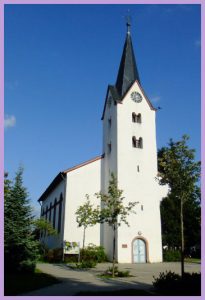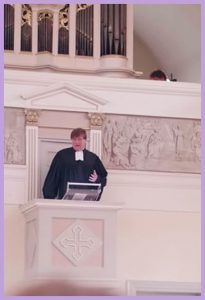
Interesting things to know about the history of the church of Gräfenhausen
From 6th – 8th century Gräfenhausen was part of the mother church Groß-Gerau.
In the year of 1310 a chapel of Martin was already documented in Gräfenhausen, but the oldest part of the church,
which ist the still existing tower, dates back to 1200.
Indications for that are its heavy construction, the peculiar profiling of the stoned door walls of the portal and furthermore the two on two double linked arched windows in the belfry. The original small medieval church of the 13th century was very narrow and dark.
In the Thirty Years War (1618 – 1648) it became ruinous and derelicted, but after the Christian Reformation (1537) it was still used for 270 years (until 1807). Many times it got repaired and changed In this period.
The most important change happened in 1771:
The organ of the workshop of Philipp Ernst Wegmann, Frankfurt on the Main, was built in (an earlier organ was already documented in 1729).
In the year of 1807 the church had to be closed because it was in a stat of dilapidation. For eight years the pastor ministered in the summertime underneath a nuttier and in wintertime in a room of the downhill.
In 1815 the nave was pulled down. The tower of the old chapel of Martin remained. It is our bell tower and the oldest building of Gräfenhausen. The new construction was already planned for 1790. It was concepted by Georg Möller (1784 – 1852, since 1810 grand ducal, hessian major director of construction) and constructing started on the 12th of October 1816. Our present day church was inaugurated on 18th of July 1818.

We have the only parish church, for which Moller asked Josef Sandhaas (court painter of Darmstadt) for painting the frescos beside the pulpit and on the balustrade of the organ with Frieze and Grisaille paintings. On the left hand side they show the biblical theme of Markus 10, verse 13 to 16:“ let the children come to me.“
On the right hand side they show the biblical theme of Lukas 2, from verse 41 on :“twelve years old Jesus in the temple.“
The cultural heritage preservation evaluates our church with these words:
Because of its historical and artistic meaning the church and its interior has to be preserved as a cultural monument.
The cemetery
Originally the cemetery was the „yard“ around the church (so called church-yard), God´s acre for the departed to rest on holy ground. Until the beginning of the 17th century the dead of Gräfenhausen and Schneppenhausen were buried here. Because of the very early relocation of the cemetery to the outside, no traces of its original purpose can be found on the churchyard. The location of our present day cemetery between both neighbourhoods dates back to 1612.
The bells
The first purchase of a bell had been in 1662. The bell of 1662 had a weight of 207 pounds and the bell maker wrote a warranty for a year. This bell shuttered in 1745. Since the new one had a bad sound, a third one replaced it. In 1768 a new bell had to be bought again. Its diameter is 88 cm and it weights 440 kg. Today it is still hanging on the same spot.
In 1841 a second bell was added. Finally a third bell was added in 1856. In World War I these two bells were taken away (1917).
In the year 1925 two new bells were purchased. They had been taken away at night and were melted down in World War II (1941)
Since the parish fair of 1952 two new bells complete our chimes:
- A borrowed bell of the protestant church of Pritter (isle of Wollin), weight 215 kg, called „Bell of home).
- a new bell with a weight of 280 kg, casted in Sinn. It is dedicated to the fallen of the world wars 1914-1918 and 1939-1945. It is called „Bell of remembrance of the fallen“
The ringing of our three bells ist called „Gloria chimes“ with the tones a – h – d.
Facts an figures of the church
The tower has a base of 4,5 by 4 metres.
Its height is 36,70 metres – including the weathercock.
The nave has a length of 19 metres and a width of 12,50 metres.
The choir has a length of 6 metres and a width of 8 metres.
It is a pulled in rectangular choir, which includes both sacristies.
Dr. Günter Hoch
Pfarrer Helmut Stiller

